An Introduction to Mayflower Voyage
It was Thursday, November 9, 1620, when a group of passengers from Scrooby, Nottinghamshire, referred to as the Pilgrims, finally reached the coast of New England aboard a small, cramped ship called the Mayflower.
Driven from their homeland by a vengeful king, 102 people crowded aboard the Mayflower and set sail on a 3-month treacherous and exhausting voyage across the Atlantic. Living conditions were poor and passengers risked dying from illness and lack of food and clean drinking water.
When the pilgrims finally arrived on the coast of North America, they were hungry, sick and exhausted after months of traveling across the ocean. They had all managed to survive the long and tough journey except for one crew member who died along the way.
Although the pilgrims were exhausted, sick, and cramped, they eventually landed at Cape Cod, New England. This was not their intended first stop, but due to the strong waves and strong winds, the navigation system misled them and they ended up here instead of Northern Virginia, which was their original destination.
This area was called Plymouth by explorer John Smith. The pilgrims decided that they had been on the ship long enough, and this was a suitable place to build their colony.
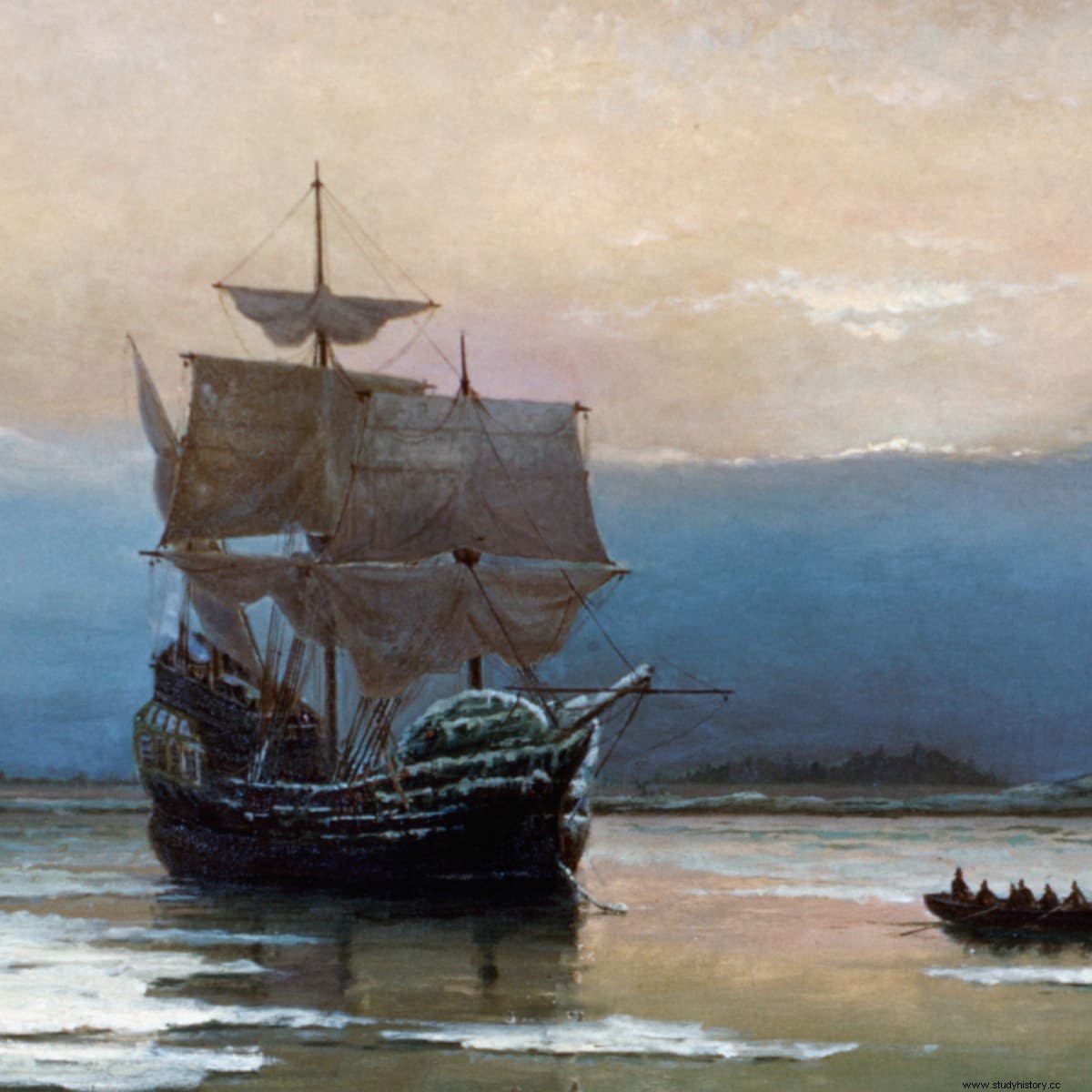
The Pilgrim's arrival in Plymouth
Although other colonies had arrived in Plymouth before them, this was the first time anyone had arrived out of necessity to survive. In the past, people in Plymouth landed in hopes of expanding their businesses such as the fur trade, tobacco or other sales of goods and services.
However, the pilgrims were people of strong faith who made a sacrifice to leave everything, including their loved ones and earthly possessions, and sailed to new horizons where they could worship as they wished. There was no easy way for them. In the first year after arriving in Plymouth, they lost almost half of their people.
Pilgrims would soon learn how to survive in their new environment by cultivating crops, hunting, capturing and skinning animals, and safely learning to explore their newfound surroundings.
They wanted to enter into alliances with their Native American tribes and develop trade. Through religious freedom, the newfound life of pilgrims in North America would consist of a cohesive society that would gradually begin to grow in size over the years.
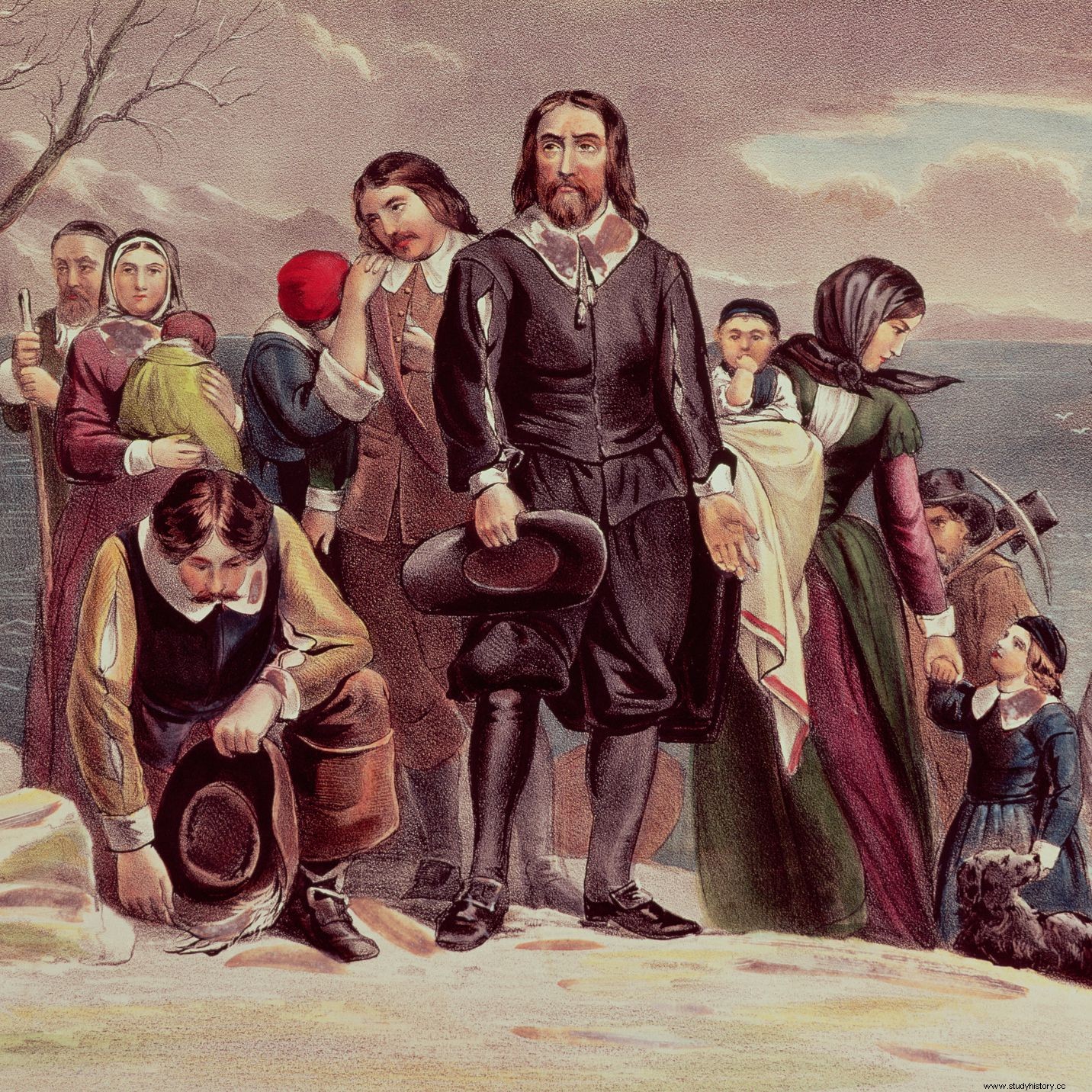
A religious background
In the 17th century, Western Europe was ruled by the Roman Catholic Church. The religion of each person was determined by the pope. The pope was considered to have higher power than lords or kings at that time.
The pope had the power to sign treaties, enter into alliances and go to war. With great power also came corruption.
It was the lack of religious freedom that made the pilgrims look for a way out, a better life than what Western Europe had to offer them.
Pilgrims were a group of people who traveled across the Atlantic in search of a better life for themselves. The journey was long, dangerous and full of disease and hunger. Despite the treacherous difficulties they endured, they continued on their journey.
They arrived at the destination and established a new settlement that included congregational churches. Congregationalism is a Protestant type of church that practices independently and governs its own economy and affairs.
Congregationalism represents 0.5% of the worldwide population of the Protestant religion. Their customs and religious ideas have influenced many other important aspects of Protestantism around the world. Church communities in the United States and the United Kingdom trace back in history to:
- Non-Conformist Protestants
- Puritans
- separatists
- independents
- English religious groups from the Civil War
Congregational churches can now be found all over the world, including Ireland, Canada, Australia, the United States, the United Kingdom, South Africa and New Zealand.
Many congregational churches in Britain can trace their ancestry to the Protestant denominations formed on a theory of unification by the English separatist Robert Browne as early as 1582. Other accounts trace its origins even earlier back to London Underground Churches in the 1560s.
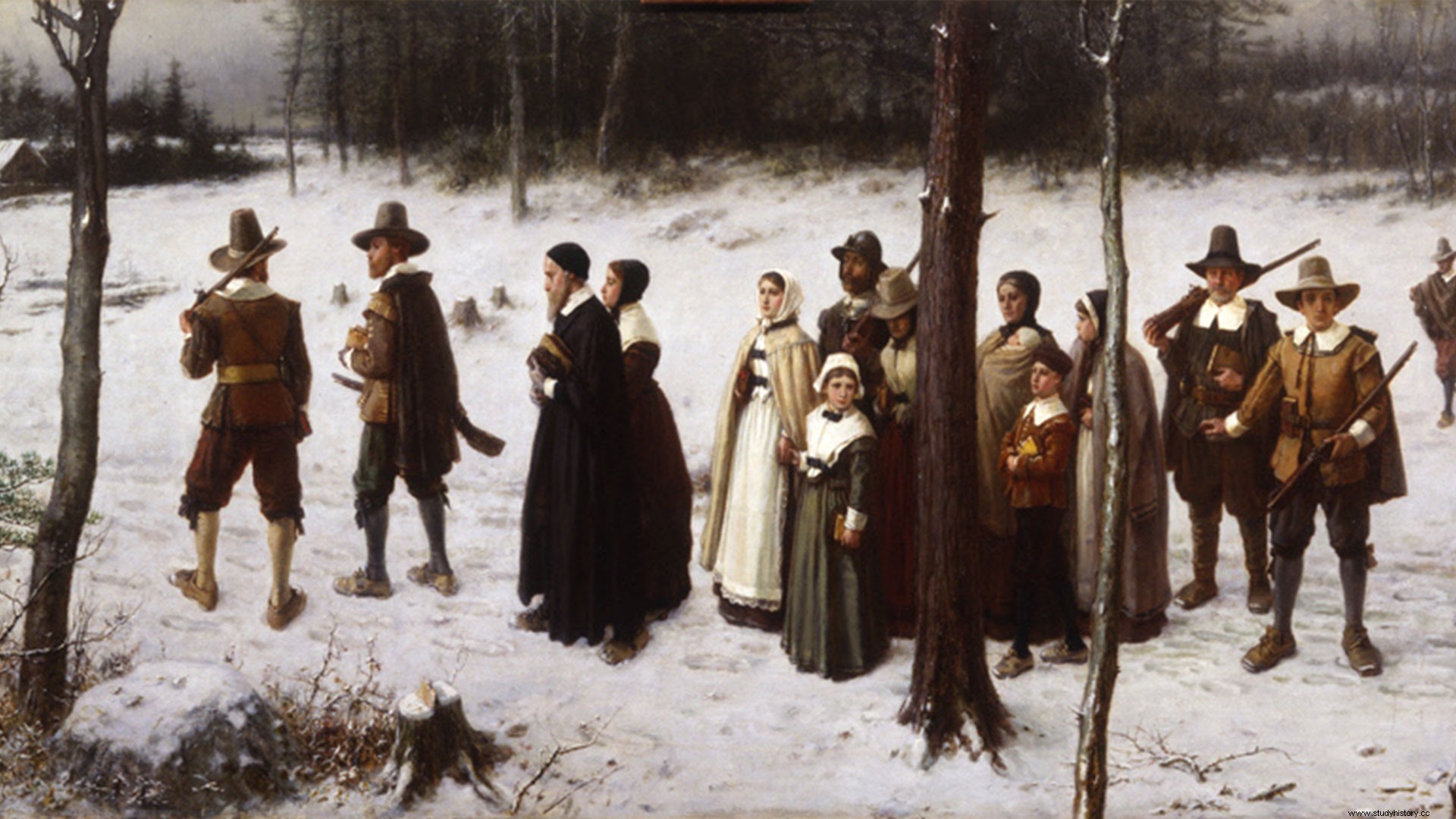
Pilgrim's first contact with the natives
On November 11, 1620, sixteen men were hand-picked to land on the coast of New England and explore the area for safety while gathering firewood. They did not report anything that would be considered unsafe, and soon after, the women were allowed to leave the ship to wash clothes and return.
During a trip to the coast on November 15, the pilgrims crossed paths with Indians for the first time. At first glance, the natives were frightened by the white pilgrims, and they ran in cover into the nearby forest.
The natives hid well. After exploring the forest for 3 days, the pilgrims could not find the Indian hiding places. However, they found corn and grain that the natives buried. The pilgrims stole some of the food as they all starved after their last voyage aboard the Mayflower which had run out of food.
Ten days later, the pilgrims found even more corn and baskets filled with beans and wheat. They took the food, but agreed to pay the natives back when they were able to establish their settlement.
The pilgrims found the perfect place to start their settlement at Plymouth Rock. Those who were not sick, or had recovered from illness, were sent ashore to build huts. They worked hard on the settlement over the winter. They built seven houses and four communal houses out of the nineteen they had hoped to build. The winter was so cold and harsh that they could not achieve as much as they had hoped.
The pilgrims did not celebrate traditional holidays, including Christmas or XNUMX. Christmas day. During these holidays, they continued to work hard to build their homes. Every night after a long day's work, they returned to Mayflower, where women, children, and the sick awaited their safe arrival.
It took the pilgrims a long time to build a house due to lack of labor and more and more men became ill or worse, died. The men went to do the work, working very long hours in the cold and snowstorms. When a house was finished, they used it as a sick house to treat the sick.
During the winter months, they continued to build the rest of the settlement, including a wooden building that could hold a cannon. Fort Hill served the pilgrims as a place to defend their new settlement against enemy attacks.
It was a terribly bitter and cold winter that took the lives of many pilgrims buried in unmarked graves to hide them from the natives who saw them working from the forest.
During this time of great loss, the first birth also took place. There was a boy named Peregrine. His mother's name is Susanne White. However, the father of the firstborn died of "general illness". And so the first baby born to the Plymouth colony was considered an orphan.
The winter months were so harsh that only three families managed to survive, including:
- The family of William Brewster
- Five unmarried women of 18
- Ten unmarried men of the first twenty-nine
Of the survivors, the hard-working included William Brewster and Miles Standish, whose work consisted of collecting firewood, cooking, cleaning and caring for the sick as well as building new homes. It was noted in many journals that they never complained about the heavy workload they have. Instead, they continued day after day to complete the heavy work without any complaints.
During the long winter months, natives were occasionally seen approaching the settlement. However, they were easily intimidated when they were noticed by the Mayflower pilgrims, and they kept their distance.
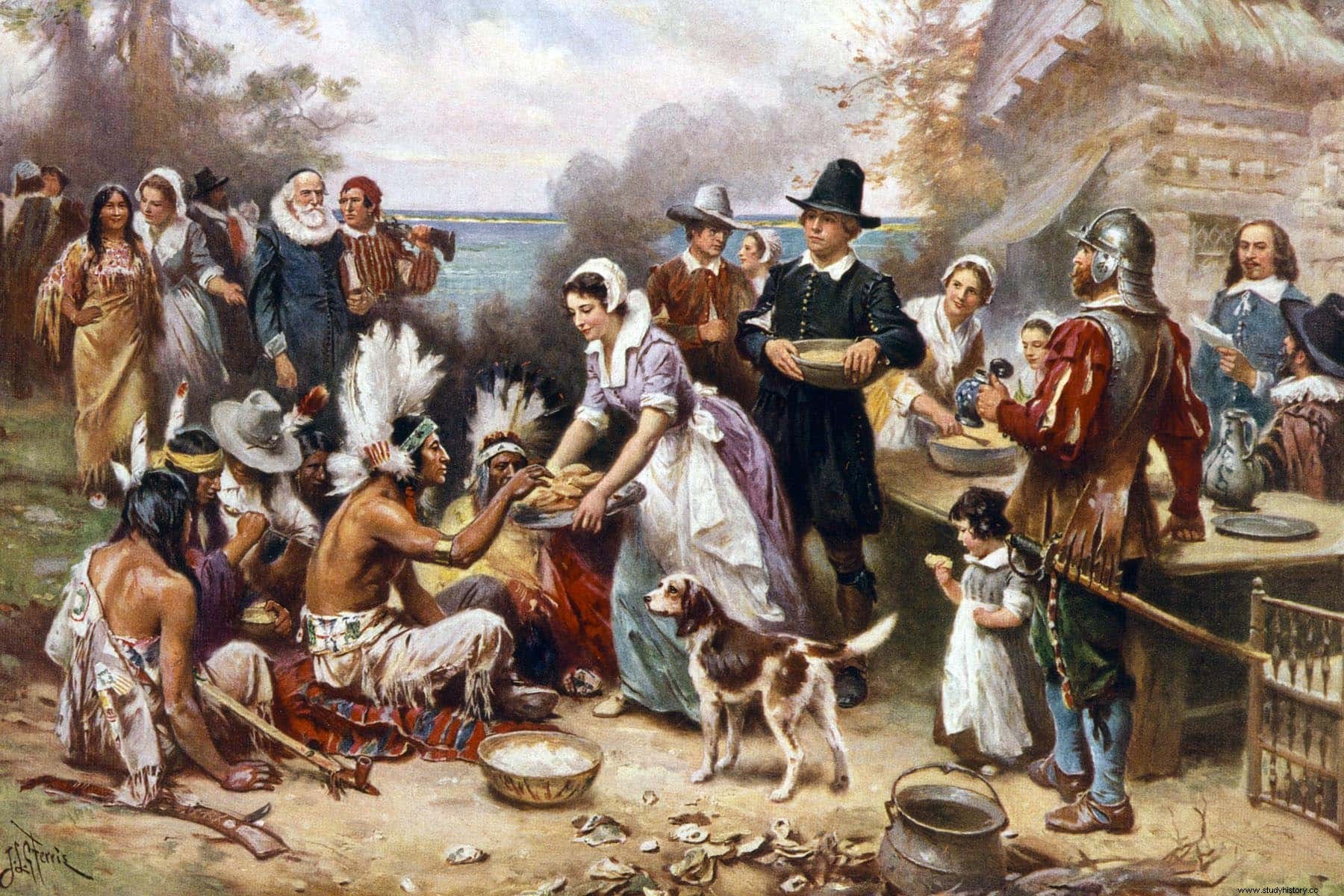
First native encounter
It was on March 16, 1621, that a brave native would have enough courage to be seen in the common house where the pilgrims had all gathered for their morning meeting. At first glance, the pilgrims were frightened by the presence of the natives. They were even more shocked when he started speaking to them in English. He welcomed them and told the pilgrims that his name was Samoset.
He also informed the group that he was from the Abenaki tribe and that he was a sagamore who was the leader of a group of his tribe. He came from Pemaquid Point Maine, where he was taught to speak English by the fishermen and hunters in the area.
The pilgrims learned that the site of their Plymouth colony had been occupied by many people before them, but they had all died of disease except for one survivor named Squanto, a Native American man.
On his later visit, Somerset would introduce the pilgrims to Squanto, who would offer to serve as a liaison for the pilgrims and the nearby colony of Massasoit, which had 60 men waiting to speak to the new English pilgrim settlers.
After carrying several messages back and forth between the settlements, Squanto finally arranged for the two colonies to meet on March 22, 1621. Negotiations between the natives and the pilgrims took place with Squanto as interpreter between the two separate languages.
The natives promised to return some of the pilgrim's stolen tools, and in return the pilgrims would pay for the stolen food they took from the natives. They agreed to keep weapons out of sight when they met, and if any of them were attacked by a third party, they would come to each other's aid.
The agreement seemed fair between the two parties and would remain in force for the next fifty years.
Squanto would prove to be a loyal friend of the pilgrims who would stay and teach the pilgrims how to cultivate the land and prepare to plant better crops by using fish as fertilizer, which also helped the pilgrims to cultivate 20 acres of corn. , barley, and peas the following year. It was a great help to them, considering that their first year of crops was barely abundant despite all their hard work that year.
Squanto also taught the pilgrims how to hunt eels by pulling the eels out of the mud with their feet. This eel hunt soon became the pilgrims' annual hunting tradition. The pilgrims also quickly learned how to collect skins, which helped them pay off their debts faster than they had previously expected.
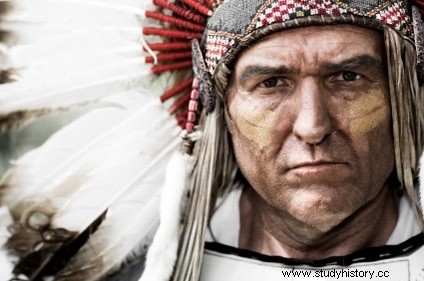
The Pilgrim's first Thanksgiving
The pilgrims would soon begin to thrive among their Native American friends, and by the end of the summer, the Plymouth colonists would establish contact with the Massachusetts tribe in what is now known as Boston Bay.
Squanto had warned the pilgrims that this tribe was not very kind, and had previously hunted for Europeans. However, the pilgrims treated them with good intentions and respect and ended up establishing trade with them.
Autumn was plentiful that fall, and the pilgrims enjoyed their new settlement so much that they decided to hold a festival to celebrate their newfound freedom and life in America.
In early October of that year, they celebrated their first Thanksgiving. This celebration continued to be an annual tradition of descendants of pilgrims as well as throughout North America.
In 1863, Abraham Lincoln introduced Thanksgiving as a national holiday. The actual date was later moved to November instead of the original Thanksgiving that the pilgrims celebrated in October.
The very first Plymouth Thanksgiving was religious in nature, with pilgrims preparing for a great feast and celebrating their bountiful harvest for three days. They invited all their native neighbors, who also brought sacrifices to the festivities. Their offer included:
- Deer
- Wild Birds
- Fish
- Hummer
- Wild Berries
The harvested food was plentiful, and the English settlers, along with their Native American neighbors, celebrated a traditional celebration of friendship, loyalty, and a new beginning.
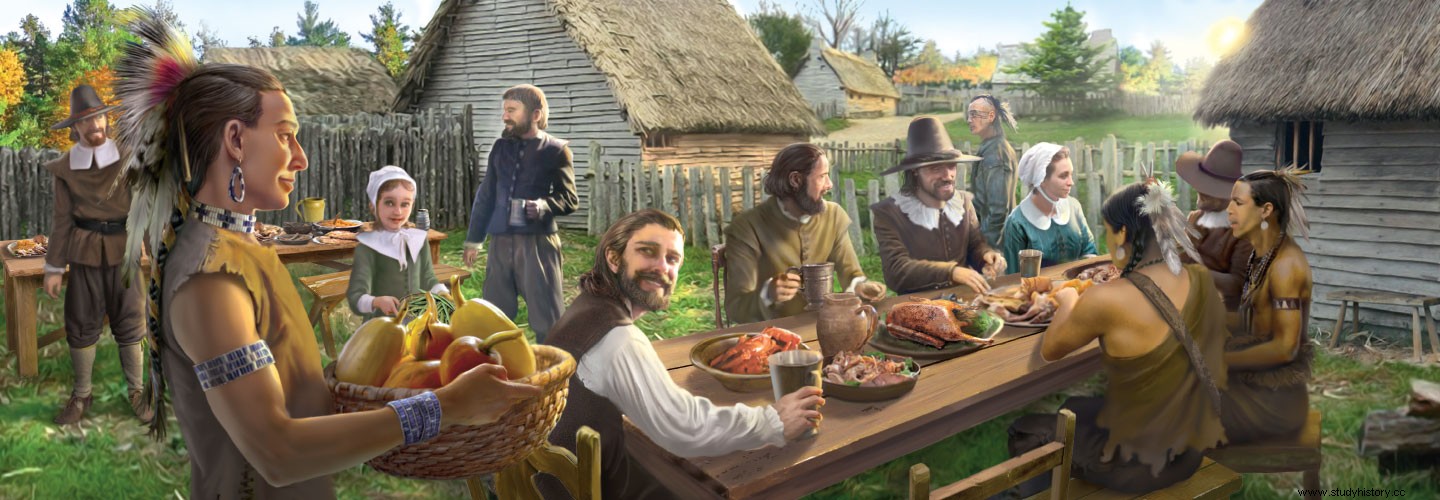
Expansion of the colony
A year after the arrival of the Plymouth settlers on Cape Cod, a second ship arrived from England. This second ship was sent by the Merchant Adventurers Company and it had 37 new settlers on board.
Among these new passengers included some family members of the first Plymouth colonists. William Brewster's son Jonathan arrived. Edward Winslow's brother also arrived. His name is John. Other people who arrived were Robert Cushman, his son Thomas and Philip Delanco, who was known as the ancestor of President Franklin Delano Roosevelt.
These newcomers were all accepted to the colony with open arms. However, they had no supplies or money with them, and they put an extra burden on the colony to share food and shelter with them.
The new ship also delivered signed papers to the colony from Sir Ferdinando Gorges and members of the Council of New England. In these letters, the pilgrims promised 100 acres of new land each if they promised to work for 7 years.
In the summer of 1622, two more ships arrived in Plymouth, called the Swan and the Charity. These ships carried sixty men to join the colony. The pilgrims had to find a way to feed all these extra mouths. However, the new settlers offered more manpower to work in the fields and do tasks for the expansion of the colony.
In the following years, the Plymouth colony would grow steadily. By March 29, 1630, four new ships arrived from New England. These ships included:
- Arabellaen
- Talbot
- Ambrose
- The Jewel
- And nine more ships
These ships carried over 1,000 new Puritans to Massachusetts, and it did not take long for all that manpower to build more cities in the Massachusetts Bay Colony. The Plymouth pilgrims suddenly found themselves with many neighbors from the same religion all over the coast of Massachusetts.
However, these newcomers were not separatists, which plagued the pilgrims, who wanted to convert them and fill them with the same faith they had. In time, the Puritans would take over the trading post of Plymouth Pilgrims and take a monopoly on the trade in beaver skins, leading to a real struggle for the colony to pay down the debt.
In Boston Bay the crops grew well and the Puritans never had to experience the same difficulties that the first pilgrims had to endure in order to survive and pave the way for the rest of the settlers.
Children already had access to schools and education and would probably have a prosperous future in the new settlement.
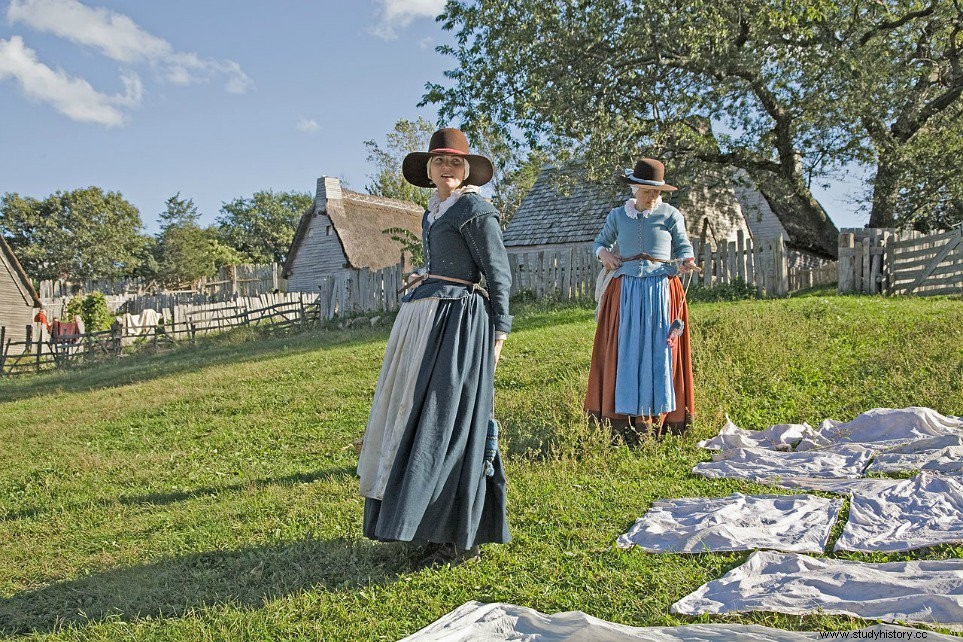
The Puritans
The government carried out brutal punishments against the Puritans for turning away from God's word. Even children were punished for laughing during a sermon with beatings and whips. Large fines were also imposed on parents who missed church gatherings. For more serious crimes, people were actually hanged in Boston. They were also subjected to public beatings or imprisonment for less serious offenses.
In Boston, adulterers were marked with a large red A on their clothes so that everyone could see that they had committed a sin. In Plymouth, adulterers were forced to wear two large red letters on their clothes, one A and one D.
Records from the Plymouth Colony's Earliest Courts
Records from Plymouth Colony's earliest courts have, in fact, survived over the years almost entirely intact. Before the Civil War, these items were published in a set of 12 volumes and reprinted on several other occasions since. Some of the court records go back to 1623, to 1691 when the Plymouth Colony merged with Massachusetts Bay and provide an insight into how pilgrims viewed their moral and religious views.
In 1863, there were 5 crimes punishable by death in the Plymouth Colony, including:
- Intentional homicide
- Forms a single compact with the devil using witchcraft
- Intentional burning of ships or houses
- Sodomy, rape and wiretapping
- infidelity
The following are actual documents found in the Plymouth Colony Records Book.
"According to Plymouth Colony Records, they never killed anyone for infidelity. However, Mayflower passenger William Latham's wife Mary was hanged for infidelity in the Massachusetts Bay Colony in 1644."
"In 1639, Mrs. Mary Mendame of Duxbury was convicted of infidelity against an Indian named Tintin, and was sentenced to whipping displayed along the city streets and ordered to wear an AD on her clothes. If she was found without, it would be marked on her forehead. "
"In 1641, an unfaithful affair between Thomas Bray and Mrs. Anne Linceford was discovered. Both parties were sentenced to public flogging, and they were both ordered to wear AD marks on their clothes. "
"In 1662 Thomas Bird was sentenced to two lashes for having committed" several infidelities and attempts against Hannah Bumpass, who was also sentenced to be whipped once "for giving in to him and not resisting him as she did should." Bird was also sentenced to pay Hannah £ 10 for "gratification for the wrong he has done to her".
"The first person to be executed for murder was the Mayflower passenger John Billington, who was hanged in September 1630. He had shot down John Newcomen, apparently as a result of an ongoing quarrel."
"Arthur Peach, Thomas Jackson, Richard Stinnings and Daniel Cross were convicted of the murder of an Indian named Penowanyanquis in 1638:the motive was a robbery. Daniel Cross escaped custody, but the others were all executed by hanging."
The triple hanging sent a strong message that the Plymouth Colony would treat the murder of Indians the same as the murder of a white man.
"In 1648, Alice Bishop was hanged for cutting the neck of her 4-year-old daughter Martha with a knife while Martha slept in her bed:perhaps the most shocking and gruesome crime in Plymouth Colony history."
"There were two witchcraft trials in the Plymouth Colony, decades before the more famous Salem witchcraft trials in 1692."
"Both Plymouth Colony witchcraft cases ended in innocent verdicts:in fact, the prosecutors were fined by the court for making false accusations."
"In 1642, a 16-year-old boy, Thomas Granger, a servant of the Mayflower passenger Love Brewster, was captured (and later admitted to) animal acts with various of Brewster's domestic animals, and was executed (along with the animals) according to biblical precedent. (Deuteronomy 15:XNUMX). »
"In 1660, Thomas Atkins was convicted of incest with his daughter Mary. The jury did not find him guilty of the main crime of incest, but sentenced him to whipping for "incestuous attempts" against his daughter "in the chimney corner", while he was drunk with a drink.
The view of women in the 17th century
Women were considered more than just a resource for their husbands in the new world. They were treated equally with men and were not servants. Beating a woman was strictly forbidden, and everyone who was caught in it had to pay large fines.
But having said that, women still did not have the same rights as men. They were not allowed to own property or take government roles in the colony. However, they were given religious freedom equal to men, and that was enough to attract many women to America.
In 1649, England became a commonwealth when Oliver Cromwell took control of England's power. He later ruled the British Isles as Lord Protector from 1953 to 1658. The Puritans and Pilgrims celebrated his victory.
The Puritans finally had the choice to make their own decisions regarding religion. Two years after Cromwell's death in 1658, King Charles II took control of the monarchy in England
Although King Charles II was a king, the Puritan revolution of 1642 allowed England and America to develop a two-party political system. (The English Civil War)
In the year 1836, the pilgrims and the Puritans thrived side by side.
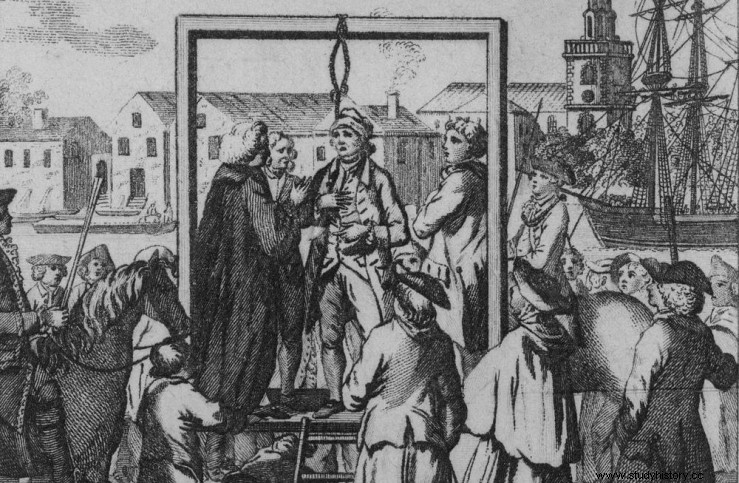
John Alden and Priscilla Mullens
John Alden was born in 1599 in Essex, England. He was a crew member of Mayflower. Employed as a cobbler by the ship, he was responsible for looking after the ship's barrels. Although not a settler, John decided to stay in Plymouth with the other English Plymouth pilgrims instead of returning to England on the Mayflower.
He married Priscilla Mullins around 1622. She was a passenger on the Mayflower. Priscillas' entire family tragically died the first winter they arrived in Plymouth.
John and Priscilla had 10 children together, named Elizabeth, John, Joseph, Priscilla, Jonathan, Sarah, Ruth, Mary, Rebecca and David.
Their story is a tale of love and romance in times of unrest and insecurity that prevailed for many years after Mayflower arrived in Plymouth.
The Alden House Historic Site and the property on which it is located are still part of the original land that was given to John and his wife Pricilla in 1627. It was designated a Natural Historic Landmark in 2009 and is an important part of American history that provides visitors with a look into some of America's most famous pilgrims in history.
The Alden farm was built in 1700 by Jonathon Alden, most likely before his father's death. The house would remain occupied by the Eldon family for many years. Today it is run as a museum where others can see the legacy as the home of a basic American settler.
A poem was written about the love of John and Priscilla Alden by Henry Wadsworth Longfellow entitled The Courtship of Miles Standish. Here are some familiar lines from the poem:
"I have fought ten battles and plundered and demolished a city
Come and sit down, and to relate to me and everything that has happened.
Then John Alden spoke and told about the amazing adventure.
From beginning to end, just as it happened;
How he had seen Priscella, and how he had accelerated the courtship.
Just smooths a little, and softens her rejection.
But when he got far on the words Priscilla had said.
Words so tender and cruel:
Why do not you speak for yourself, John?
The captain of Plymouth sprang up and stomped on the floor.
To his armor clanked on the wall where it hung
With the sound of a creepy ... "

Thanksgiving as it is celebrated today in America
The first pilgrims who arrived from Mayflower, Massachusetts, were responsible for values that are still practiced today throughout America and around the world in many other countries, which celebrate the traditional celebration annually.
Every year, Thanksgiving Day is celebrated on the fourth Thursday in November to commemorate the first pilgrims who survived the long and dangerous 3-month trek across the Atlantic and survived their first winter in 1621. Families around America cook a turkey and come with the family to celebrate with good food and to thank them for all they have been given by their founding families.
Before the pilgrims could begin their new life, they solved some major problems. They later drafted an agreement known as the Mayflower Compact which became their new government to ensure that everyone in the new colony would agree and follow the same set of rules. This pact allowed them to live as a colony that promised to live by the same rules as each other and treat each other with respect and dignity.
In the Mayflower Compact, pilgrims promised their loyalty to laws they would make themselves.
William Bradford was a dedicated Puritan who arrived in Plymouth from Yorkshire, England. His influence would help shape the Plymouth colony for 30 years. He was also known for his strong contribution to the Mayflower Compact.
"The Plymouth Colony was the first American government in Western history between each other and not with a monarch."

The National Monument to the Ancestors
Formerly known as the Pilgrim Monument, the National Monument to the Forefathers commemorates the history of the Mayflower Pilgrims and is located in Massachusetts.
This 81-foot-tall granite statue was built in memory of the brave passengers who sailed aboard the Mayflower. It is believed to be the largest statue in the United States. It was designed by a Boston sculptor named Hammatt Billings. It contains metaphorical figures depicting the virtues of:
- Faith
- Moral
- Education
- Law
- Liberty
The dedication on the monument reads:"National monument to the ancestors."
"Raised by a grateful group of people in memory of their work, sacrifices and sufferings for civil and religious freedom."
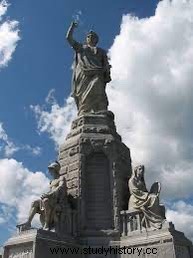
The original design of the monument required it to be almost twice as high at 150 feet (just below the height of the Statue of Liberty at 151 feet). However, the end result measured 81 feet instead, which is still significantly high and the largest granite statue in the United States.
The monument is available for everyone to visit for free and is open to the public between April and November. The Site is managed and maintained by the Massachusetts Department of Conservation and Recreation.
Visitors are also welcome to bring a picnic lunch and their dogs or pets as long as they are on a leash to take advantage of and enjoy the monument's spacious lawn. Sit back and enjoy the monument as you remember the pilgrims from Plymouth Colony who founded Thanksgiving.
